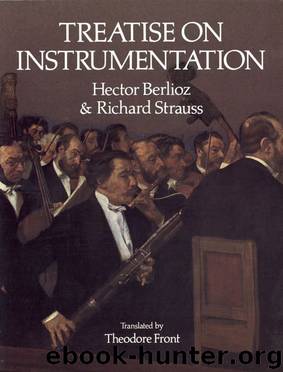Treatise on Instrumentation (Dover Books on Music) by Hector Berlioz & Richard Strauss

Author:Hector Berlioz & Richard Strauss [Berlioz, Hector]
Language: eng
Format: epub
Publisher: Dover Publications
Published: 2013-07-24T03:00:00+00:00
If several different keys are used, it is better to assign the higher keys to the first horns and the lower keys to the second horns. Another precaution, frequently disregarded by many composers, is the avoidance of changing from a very high to a very low key (or vice versa) during a piece. For example, the sudden transition from high A to low Bb is very difficult for the player. With four horns now available in all orchestras, such awkward skips are easily avoidable.
Up to this point, Berlioz’ text is obsolete and is only of historical value. (See the appendix at the end of this chapter.)
The horn is a noble and melancholy instrument; but the expression and the character of its tone is such that the instrument is not limited to any particular type of composition. It blends well with the general harmony. Even a composer of limited skill can employ it as he sees fit—either prominently or in a more unobtrusive though useful role. In my opinion, no composer has used the horn in a more original, poetic and accomplished fashion than Weber. In his three masterworks, “Oberon”, “Euryanthe” and “Freischuetz”, he has endowed the horn with a new and wonderful language—a language which, before him, only Méhul and Beethoven understood, and whose purity has been preserved by Meyerbeer better than by anybody else. Of all the orchestral instruments, the horn is the one for which Gluck wrote least felicitously. A simple scrutiny of one of his works will suffice to prove his want of skill in this respect. However, we must cite as a stroke of genius the three horn tones imitating Charon’s conch in the aria “Caron t’appelle” in his opera “Alceste”. The medium C is repeated three times by two horns in D in unison. The composer requires the bells of the two horns to be placed one against the other, so that they serve mutually as “sordines”. The tones bounding against each other sound as if emanating from a distant cave. This produces a very strange and dramatic effect:
Download
This site does not store any files on its server. We only index and link to content provided by other sites. Please contact the content providers to delete copyright contents if any and email us, we'll remove relevant links or contents immediately.
The Goal (Off-Campus #4) by Elle Kennedy(13210)
Kathy Andrews Collection by Kathy Andrews(11342)
Diary of a Player by Brad Paisley(7272)
What Does This Button Do? by Bruce Dickinson(5937)
Assassin’s Fate by Robin Hobb(5866)
Big Little Lies by Liane Moriarty(5526)
Altered Sensations by David Pantalony(4872)
Pale Blue Dot by Carl Sagan(4631)
Sticky Fingers by Joe Hagan(3916)
The Death of the Heart by Elizabeth Bowen(3345)
The Heroin Diaries by Nikki Sixx(3327)
Beneath These Shadows by Meghan March(3156)
Confessions of a Video Vixen by Karrine Steffans(3106)
The Help by Kathryn Stockett(3023)
How Music Works by David Byrne(2969)
Jam by Jam (epub)(2882)
Harry Potter 4 - Harry Potter and The Goblet of Fire by J.K.Rowling(2816)
Strange Fascination: David Bowie: The Definitive Story by David Buckley(2703)
Petty: The Biography by Warren Zanes(2578)
